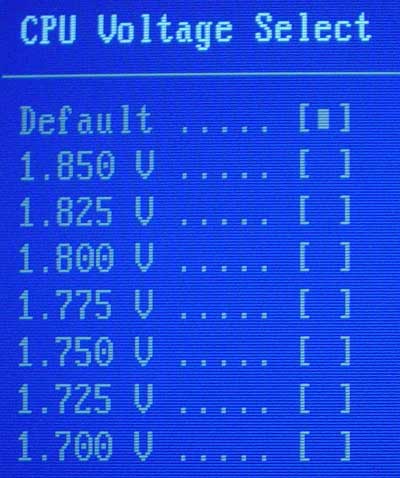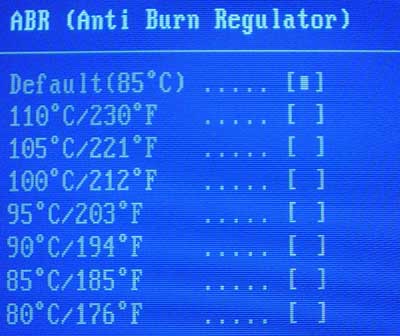Soyo KT400 DRAGON Ultra Platinum Edition: Full-Featured KT400
by Evan Lieb on September 27, 2002 2:40 AM EST- Posted in
- Motherboards
BIOS and Overclocking
The Soyo KT400 DRAGON Ultra comes with the Award BIOS, which is one of the more common BIOSes out there.
You can tell Soyo did some modifying with this BIOS once you look through the "Soyo Combo Feature" section. This section features lots of options, including several VDIMM, Vcore, and AGP voltage tweaking adjustments. In addition, you get some very nice PCI Divider options that go up to a value of 6. Thankfully you get official 333MHz FSB Athlon XP support with the KT400 Ultra, so you should be able to just drop in AMD's future 333MHz FSB CPUs with ease.

As shown in the picture above, you're allowed to adjust CPU Vcore all the way up to 1.85V in .25V increments. This is fairly high for most overclockers, although not quite enough for the extreme .18-micron Athlon XP overclockers out there. Thoroughbred Athlon XP users might be more satisfied with these Vcore adjustments though.
There are also VDIMM voltage tweaks available up to 2.8V. Normally though,
2.5/2.6V should be fine for your memory, even if you're overclocking fairly
high. For those that plan on doing video card overclocking, there's AGP voltage
adjustments available up to 1.8V, but no other video overclocking options are
present.

We really appreciate the inclusion of a plethora of memory settings for the KT400 Ultra. Usually dubbed the "Advanced Chipset Features" section, Soyo instead includes a section in the Soyo Combo Menu for "Advanced Tune-up Settings", which allows you to adjust DRAM Timing Mode, CAS Latency, Bank Interleave, Precharge to Active, Active to Precharge, Active to CMD, Command Rate, Queue Depth, and Burst Rate. We are very pleased to see this many memory tweaking options available, and hope to see similar RAM flexibility in future motherboards from now on.

Another nice BIOS feature included with the KT400 Ultra is what Soyo calls their "Anti Burn Regulator." Essentially, the Anti Burn Regulator is supposed to prevent your Athlon XP CPU from overheating if it reaches a certain temperature using the CPU's on-die thermal diode.

The default cutoff temperature in the BIOS is 85C (185F), however you're allowed to adjust that value anywhere from 50C (122F) to 110C (230F).
For those unlocking their processors, you're given a wide range of multiplier options spanning from 3X to 18X. All the overclocking tests conducted in our labs are done with an unlocked Athlon XP 2000+ (.18-micron Palomino) processor. So for this review, like our ASUS A7V8X and ECS L7VTA reviews, we lowered the CPU's multiplier to see what the Soyo KT400 Ultras' FSB overclocking limit would be.

We decided to lower the CPU multiplier from 12.5X to 8X, and see if we could hit 166MHz FSB. Unfortunately, we were only able to hit 153MHz FSB on 1.85V (the max attainable Vcore via BIOS) using a Foxconn heatsink (thermal pad). Knowing this particular cooling setup wasn't all that stellar, we decided to go with a Volcano 7+ with some ASIII thermal compound instead. Using the same Vcore as before, we barely inched up any, hitting just 156MHz FSB.
The purpose of using an unlocked CPU for motherboard reviews is that we can very accurately test the FSB limitation of the motherboard itself, thereby isolating the board instead of the processor or some other piece of hardware. This reason alone is enough to convince us to conduct all our Athlon XP overclocking tests with an unlocked CPU.










0 Comments
View All Comments